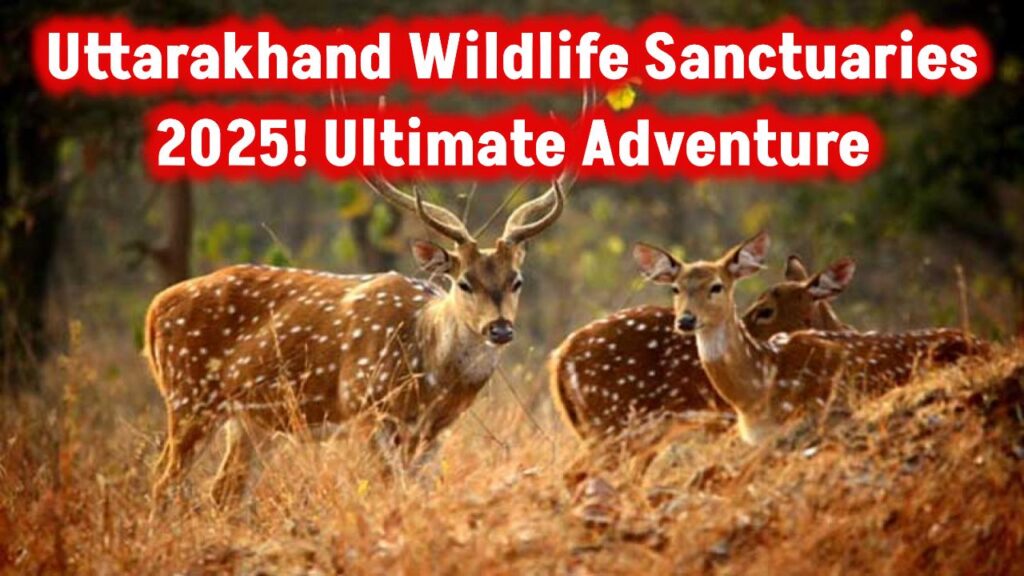
Uttarakhand, often called the “Land of the Gods,” is also home to some of India’s most stunning and diverse wildlife sanctuaries and national parks. If you’re an adventurer, wildlife enthusiast, or simply someone looking for a peaceful retreat in nature, Uttarakhand offers some of the best sanctuaries teeming with rare flora and fauna.
In this article, we will explore the best wildlife sanctuaries in Uttarakhand (2025), their unique features, conservation efforts, local eco-tourism opportunities, and how you can experience an unforgettable wildlife adventure.
Uttarakhand Wildlife Sanctuary List 2025
| Feature | Details |
|---|---|
| Top Sanctuaries | Jim Corbett, Rajaji, Valley of Flowers, Binsar, Kedarnath, and more |
| Best Time to Visit | October to June (varies by park) |
| Unique Wildlife | Bengal tigers, snow leopards, elephants, musk deer, Himalayan black bears |
| Activities | Jeep safaris, birdwatching, trekking, camping, nature walks |
| Conservation Initiatives | Project Tiger, Eco-Tourism Promotion, Community Involvement |
| Eco-Tourism Spots | Sustainable lodges, nature retreats, wildlife photography hubs |
| Official Website | Uttarakhand Tourism |
Uttarakhand’s wildlife sanctuaries and national parks are an absolute delight for nature lovers, wildlife enthusiasts, and adventure seekers. Whether you want to spot a Bengal tiger in Jim Corbett, trek through the Valley of Flowers, or watch elephants in Rajaji National Park, Uttarakhand offers something for everyone. With increased eco-tourism efforts and conservation initiatives, these natural treasures remain protected while offering breathtaking experiences. Plan your visit today for a memorable wildlife adventure!
1. Jim Corbett National Park – India’s First and Oldest National Park
Why Visit?
- Established in 1936, Jim Corbett National Park is India’s first national park.
- Known for its Bengal tiger population and diverse landscapes.
- Offers jeep safaris, elephant safaris, and birdwatching tours.
- Located in Nainital and Pauri Garhwal districts.
Best Time to Visit:
- November to June.
- The park remains closed during the monsoon (July–October).
Top Attractions:
- Dhikala Zone: Best for spotting tigers.
- Bijrani Zone: Perfect for wildlife photography.
- Jhirna Zone: Open throughout the year.
- Durga Devi Zone: Ideal for birdwatching.
2. Rajaji National Park – A Haven for Elephants and Leopards
Why Visit?
- Spans across Haridwar, Dehradun, and Pauri Garhwal.
- Rich in elephants, leopards, Himalayan black bears, and over 300 bird species.
- Offers thrilling jungle safaris through dense forests and grasslands.
Best Time to Visit:
- November to June.
- Monsoons (July-September) are not ideal due to heavy rains.
Top Attractions:
- Chilla and Motichur Zones: Great for elephant and leopard sightings.
- River Ganges: Enhances the beauty and supports aquatic life.
3. Valley of Flowers National Park – A UNESCO World Heritage Site
Why Visit?
- Famous for vibrant alpine meadows, rare flowers, and endangered animals.
- Located in Chamoli district.
- Home to snow leopards, musk deer, and the Himalayan monal (Uttarakhand’s state bird).
- Accessible only via trekking (from Govindghat).
Best Time to Visit:
- July to September (peak bloom season).
Top Attractions:
- Breathtaking flower meadows with over 500 species of flora.
- Hemkund Sahib, a sacred Sikh pilgrimage site nearby.
4. Binsar Wildlife Sanctuary – A Birdwatcher’s Paradise
Why Visit?
- Located in Kumaon region.
- Home to over 200 bird species including eagles, woodpeckers, and monals.
- Offers stunning views of Nanda Devi and Kedarnath peaks.
- Ideal for trekking and nature walks.
Best Time to Visit:
- October to March (for birdwatching).
Top Attractions:
- Binsar Zero Point: A vantage point for breathtaking Himalayan views.
5. Kedarnath Wildlife Sanctuary – The Land of Musk Deer
Why Visit?
- Located in Chamoli and Rudraprayag districts.
- Famous for the musk deer, snow leopards, and Himalayan tahr.
- Dense forests, meadows, and high-altitude landscapes make it unique.
Best Time to Visit:
- March to June & September to November.
Top Attractions:
- Musk Deer Conservation Center.
- Trekking trails leading to Kedarnath Temple.
Eco-Tourism and Conservation Efforts in Uttarakhand
1. Project Tiger
Uttarakhand plays a crucial role in Project Tiger, a government initiative focused on increasing tiger populations in protected areas like Jim Corbett.
2. Community-Based Conservation
Local communities are being involved in wildlife conservation efforts, ensuring that sustainable tourism benefits both wildlife and residents.
3. Eco-Friendly Lodges and Tourism Practices
Sanctuaries now promote eco-tourism lodges that offer sustainable accommodation, nature walks, and guided wildlife photography tours.
FAQs On Uttarakhand Wildlife Sanctuary List 2025
1. Which is the best wildlife sanctuary in Uttarakhand?
It depends on what you’re looking for. Jim Corbett National Park is the best for spotting tigers, while Valley of Flowers is famous for its stunning meadows.
2. What is the best time to visit Uttarakhand’s wildlife sanctuaries?
Most sanctuaries are best visited between October and June, except for Valley of Flowers, which blooms in July–September.
3. How can I book a safari in Jim Corbett or Rajaji National Park?
You can book safaris through the official Uttarakhand tourism website or at registered tour operators near the parks.
4. Are there accommodations inside these sanctuaries?
Yes! Jim Corbett offers forest lodges, while other parks have eco-lodges, guest houses, and nearby hotels.
5. Do I need special permits to visit these sanctuaries?
Some parks require permits, especially for trekking (e.g., Valley of Flowers and Nanda Devi). Always check the official Uttarakhand tourism site for updated guidelines.










